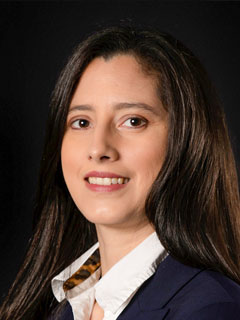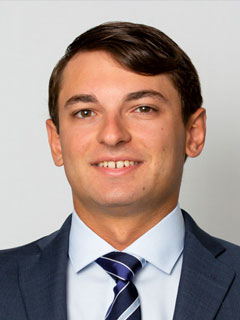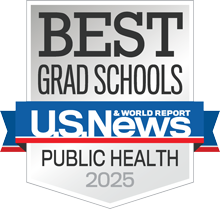Last summer, Amanda Nwaba, a medical student who served as the historian for the University of Miami Miller School of Medicine Student Government, reached out to her peers to document how they were involved in battling COVID-19 in South Florida and around the country.
The response she received was overwhelming.
This summer, Danny L. John, who succeeded Nwaba as Student Government historian, followed her lead, and asked his peers to share information on the ways they are trying to make a difference in their community. The following are some of the stories from the medical students.
Amanda Nwaba (third year):
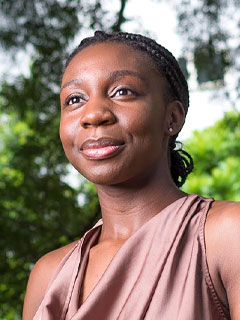
It was such an honor being able to share the work of my classmates and I’m so glad that Danny is following up last year’s piece.
The projects highlighted last year were only a sampling of how involved in our communities Miller School students are, and this follow up is a great opportunity to showcase more incredible work from our student body. The main COVID-19 related project that I was a part of this past year has been an initiative titled “Youth Tackling COVID,” which I was involved in as the 2020-2021 president of the Miller School’s chapter of the Student National Medical Association (SNMA).
We collaborated with SNMA at Florida International University for this project, which is aimed at decreasing the spread of misinformation related to COVID-19 by teaching youth how to critique public health information, communicate effectively on social media, and appreciate civic engagement.
The project is sponsored by a grant from the Association of Black Cardiologists and will consist of a series of webinars for mainly Black and Latinx Miami youth to educate and empower them as they continue to navigate their role in their community and, more specifically, their online social circles during the pandemic. We are currently recruiting students from local schools to join our initiative as we await final Institutional Review Board approval before we can begin our sessions.
It’s been fascinating collaborating across institutions and being able to follow this project during the past year, especially considering the real harm misinformation is having in our community and across the country.
Kristin Gmunder (second year):
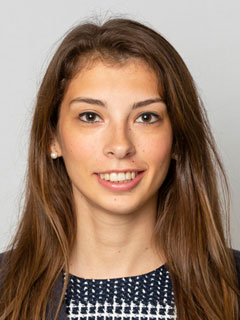
During the COVID-19 pandemic, I became involved in research focusing on the intersection of telemedicine access/usage and health care disparities examined from both the public health perspective and from a clinical informatics lens.
My interest in this area was spurred by a number of factors and was a culmination of my existing skills and previous experiences. My research during graduate school focused on the acceptability and feasibility of Hepatitis B screening among Haitian immigrants living in Miami. Now in medical school, I have had the opportunity to volunteer with the Mitchell Wolfson Sr. Department of Community Service at the Miller School and see firsthand health care disparities among underserved populations.
Additionally, with a background in biostatistics, I became more involved in clinical informatics during my first year of medical school as part of the Clinical Informatics Pathway. With the pandemic, I had the opportunity to combine these two interests: public health and clinical informatics. It was suspected that there would be an association between existing disparities and telemedicine access and usability, so we elected to examine this further.
Through this project, I had the opportunity to compile two papers with the help of the Clinical Informatics team including Dr. Jose Ruiz, Dr. Dido Franceschi, and Dr. Maritza Suarez. The first manuscript, “Demographics Associated with U.S. Healthcare Disparities are Exacerbated by the Telemedicine Surge During the COVID-19 Pandemic” (published in Journal of Telemedicine and Telecare), focuses on the disparities side. The second publication, “Factors to Effective Telemedicine Visits During the COVID-19 Pandemic” (accepted by JMIR Medical Informatics), highlights the clinical informatics aspect of this project.
Having worked on this research, I really see the intersection and necessity for research within the field of clinical informatics that pays special attention to disparities and those populations that need additional support. With this in mind, I plan to focus my future career not only within clinical informatics but with a special focus on disadvantaged populations. While I enjoy the clinical aspects of medicine, this experience has really piqued an interest in continuing this type of research in my future career.
Henry Olano (third year):
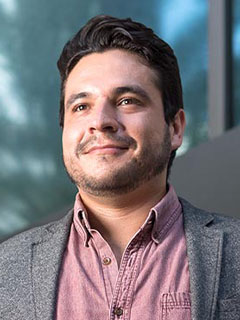
Following my summer 2020 internship in Washington, D.C., where I spent six weeks working in the office of former Rep. Donna Shalala, I attended hearings related to COVID-19 and provided updates and recommendations to the congresswoman. At the end, I felt there was more work to be done. I felt like I had the responsibility and another opportunity to engage our congressional members in underserved population public health preparedness, so that we may decrease the disproportional health outcomes we continue to see.
I updated a letter that initially sought support from the former Secretary of Health and Human Services for this cause, collected signatures from my peers and residents, and sent a copy to each of our legislators. Furthermore, I am working with the American Medical Association's Student Section Subcommittee on Global and Public Health to formally ask the new Secretary of Health and Human Services to more intently allocate existing funds toward underserved population preparedness. Because, at the end of the day, if we don't prepare and protect those most at risk, we're not doing enough to prepare and protect everyone.
Lastly, this ideal of public health preparedness has become one of the pillars of our student government this year. We aim to practice what we preach and enact positive change toward better prepared local communities.
The work I did in Washington empowered me as a medical student and as a person. I truly now believe that we are capable of transcendental change if we become engaged in the process—both locally and internationally. This idea led me and my peers to reimagine the potential of our yearly student-run medical mission to Nicaragua. Through key international partnerships and local collaboration, we are preparing to conduct our first telehealth international medical mission. If successful, this will be a proof of concept for other groups and schools to produce sustainable global health initiatives that are more in tune with the technology that is available to us. I want to take the opportunity to thank my peers, Samara Khalil, Kristi Dutta, and the rest of the Nicaragua Medical Mission team for all their work this year.
Noreen Mohsin (second year):
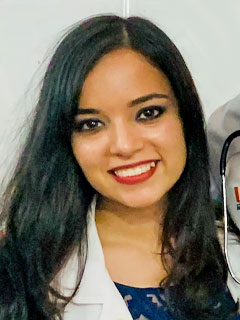
I was just about to start my dedicated study period for the United States Medical Licensing Examination at the start of the pandemic when I heard that there was a PPE shortage affecting health care providers in our community.
My grandmother had recently passed away from what my family believes was COVID-19—there was no testing available at the time—and so to honor her, I wanted to do my part in curbing the spread of the virus by 3D printing PPE for health care workers. My friend and fellow classmate, Ernesto Weisson, and I joined Miami Med COVID Help, a nonprofit medical student-run organization, as their chairs of 3D-printed PPE and began the process of designing the face shield frame.
We collaborated with Moonlighter Makerspace to design the plastic coverings of the face shields from one-ton of plastic sheeting that had been donated by the Coca-Cola Company to the state of Florida. Ernesto and I worked together on getting approval to donate the face shields to local hospitals and clinics. Because of people in our community willing to 3D print the face shield frames with donated material using their personal 3D printers, we scaled from assembling, disinfecting, and distributing hundreds of 3D-printed face shields each week to thousands of 3D-printed face shields.
Additionally, we collaborated with the University of Miami’s COVID Preparedness Team, led by the vice provost of strategic projects, to work on other prototypes that could help protect health care workers.
The pandemic most definitely altered my career focus. During a time when fear and uncertainty were prevalent globally, I saw the impact that teamwork and collaboration could have on our community.
Physicians who I had never met before cried in front of me because they were so grateful for our efforts. I have always envisioned incorporating research into my career, but this experience, where so many different groups of people came together for the betterment of our community, solidified my desire to be involved in team science and meaningful research in the future.
Morgan S. Levy (first year):
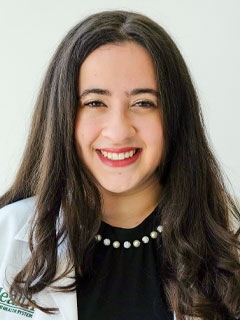
In September 2020, my grandfather passed away from causes unrelated to COVID-19. With my family back in New Jersey, I made the decision to stay in Miami and attend the funeral over Zoom.
In what started as a journal entry written after the funeral, I wrote about the unprecedented human experience of attending a Zoom funeral—from putting on a black dress even when only the top half of my body would be seen, sitting at the desk where I take my medical school exams, and not being able to speak to the small group of family members huddled in masks at the gravesite. My article, "Do you still wear a black dress to a Zoom funeral?" was published in the Journal of General Internal Medicine last month.
Moreover, I reflected on how making the decision to stay juxtaposed my responsibility as a health professional in training and a person with a life outside their profession, and the tremendous loss and burden that health care professionals and all those who have lost somebody they care about during the pandemic feel. This experience has inspired me to get involved in research to combat the burnout and burden experienced by health professionals during the pandemic in areas including family-building.
I chose an M.D./M.P.H. degree based on my interest in utilizing data-driven advocacy to improve the health and well-being of patients and realized just how impactful my role as a clinician trained in public health would be during the pandemic.
I am thankful for the epidemiologic perspective that completing public health courses during COVID-19 has provided. During the pandemic, I have engaged with social media in a professional context to stay informed. With the dissemination of the COVID-19 vaccine, a major subject of concern is whether the vaccine causes female infertility, a discourse that is prevalent on social media.
Women of reproductive age are an important demographic to consider obtaining COVID-19 vaccination, particularly due to the risk of pregnancy complications while infected with COVID-19.
Along with my mentor, who practices in reproductive endocrinology and infertility medicine, I applied for and was awarded a grant by the Association for Healthcare Social Media and Cochrane titled “Will the COVID-19 Vaccine Ruin my Fertility? A Content Analysis and Evidence-Based Twitter Campaign to Tackle Vaccine Hesitancy in Reproductive Age Women.” I hope to better understand the etiology and content of the COVID-19 vaccine and infertility misinformation and design a campaign to address these concerns by disseminating evidence-based information.
I have always envisioned my practice involving both research and patient care that inform one another, and the pandemic has strengthened this interest.
Tiffany Eatz (second year):
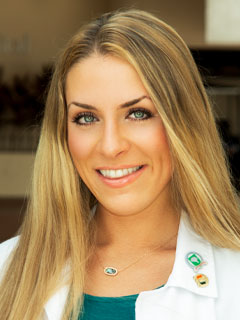
COVID-19 has turned the world upside down, disrupting society’s mental and physical health, and changing life as we once knew it. We now have been forced to become accustomed to the “pandemic life.”
I have been affected by this virus since very early on in the pandemic, because my mother was hospitalized with COVID-19—suffering pneumonia, delirium, bilateral pulmonary emboli, and deep vein thromboses. She now suffers from lasting effects, deemed a COVID long-hauler—and she may never be the same. Watching the world suffer, people dying, and my mom struggle, I was strongly driven to do something to contribute to learning more about this mysterious virus.
I am very passionate about research, and COVID-19’s wrath upon humanity moved me to investigate. Immunology, a field full of answers waiting to be discovered, intrigues me immensely. It also plays an integral role in COVID-19’s havoc upon the body. I founded the University of Miami’s Immunology Interest Group to foster interest in the field and spur medical student research in the Department of Microbiology and Immunology. Next, I came up with a few research ideas I presented to our stellar advisor, Dr. Savita Pahwa, and her team, which were accepted and able to come to fruition. I put a team of 13 medical students together, and we are working to find the associative correlations between certain biological factors and biomarkers that may increase or decrease an individual’s risk and severity of COVID-19, based on the preexisting hypothesis that ACE2 receptors act as a potential vehicle for COVID-19 entry into the body.
Additionally, I created another subsidiary study in which we will investigate immunity to COVID-19 post-infection and post-vaccination, focusing primarily on transmission rather than infectivity.
The team and I are very excited to see what results and conclusions are generated from these studies and hope to shed some light on any immunological aspect that could even slightly further the understanding of COVID-19. We are all in this together and working cooperatively and collaboratively is how we will make it out.
My heart goes out to all who have been affected by COVID-19, who have lost their loved ones, and who have risked their lives on the front line saving others. I hope we all can become happy and healthy once more.
Michael Kaiser and Lizeth Caldera (second year):
Caldera
Kaiser
The rise of COVID-19 and the sensitivity of patients older than 65 prompted the closure of assisted living facilities and rehabilitation centers to outside visitors. While the abrupt closure rendered patients somewhat isolated from the virus, it also prevented families from visiting their loved ones.
Among these issues was the shortage of smart devices that could be used for face-to-face communication between the elderly and their families. As a result, we partnered with Connect-for-COVID-19, a national organization that has sought to bring smart devices to assisted living facilities to allow the patients to communicate with their families.
By raising money and collecting devices at drop boxes, we were able to provide devices such as smartphones and tablets equipped with face-to-face video conferencing abilities at facilities experiencing shortages. Stuart Rehabilitation Center was one of the facilities where we were able to provide devices, and it was where Michael’s grandfather spent the remaining days of his life prior to the pandemic. This was a facility that meant a lot to Michael personally, and it was gratifying for us to be able to assist in such a novel crisis.
As future clinicians, this pandemic highlighted the importance of both the physical and mental challenges that are vital to patient health.
We think the events of the past couple of years have further emphasized the disparities in access to care, many of which were exacerbated by unforeseen circumstances. This experience will permanently alter the way in which we approach our future patients, particularly when it comes to addressing the personal issues that many of our patients face daily that contribute to their underlying health.
The pandemic highlighted the importance of a holistic approach to patient care, focusing on both the physical and mental aspects of patient health that are vital to well-being.
Danny Lincoln John (second year):
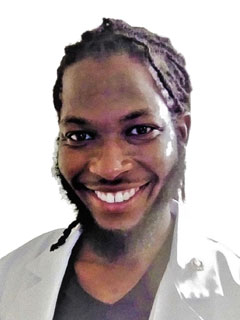
One of the best parts of being a post-grad at UPenn was the immersion into America’s founding city. I would never claim to have been born and raised in West Philadelphia, but I did live there long enough to spend a few of my days on its playgrounds and in its libraries. And, during an electrical failure in mid-2018, I spent some time on its streets.
While it shouldn’t have taken homelessness to acquaint me with the less fortunate in my neighborhood, their altruism was integral to my survival. I’d later move back to Florida to continue my education at the Miller School of Medicine. But with these life-changing experiences in mind, I did so leaving the Quaker-hood of UPenn in slowly—and still unfolding—dismay with how the most valuable education I received in my time doing research there—at the nation’s first medical school and in its first major city—would ultimately have little to do with either.
And even then, I could only imagine the true plight of the homeless, let alone what the pandemic would later make of it.
The antidote to my ignorance was waiting when I returned for Christmas break in 2020. I went back again just five months ago to find the vulnerable as I’d never seen them before—beset with the extremes of COVID-19’s telltale signs and from what I was told, often dying from them.
Yes, a vaccine was available by then, but for the vast demographic overlap between our country’s impoverished and foreign-born, the steep barrier to health care access was always going to double as an additional obstacle to getting that vaccine. And, so it did here.
To fix that, Youngji Kim, a colleague at UPenn, and I launched a nonprofit vaccination initiative focused on this population and called it Vaccination Without Language Barriers, of which Yougji is president and i am vice president. This had been planned since my December visit and its fruition would have been impossible without the help of Philadelphia’s Department of Civic Engagement.
With the department’s incredible collaboration, we administered the first shot on April 3. By early May, more than 1,000 of the most at-risk in Philadelphia’s disadvantaged neighborhoods had been vaccinated through our program—through visits to numerous venues including community centers and cathedrals.
In fact, the only frontier our efforts hadn’t reached were the homes of the sick/shut-in who most needed vaccination. I had to return to Miami before we could address that, but when I went back to Philadelphia over spring break in 2020, I helped spearhead an in-home vaccination program. As of today, our program has vaccinated nearly 2,000 people in their homes, including monks in a local Buddhist monastery. Our project, which we are trying to establish as an LLC, will be a fixture in opposing the pandemic as long as it is needed.
Since January, I’ve worked—in my ongoing capacity as head project manager at Mother Daughter Primary Care (MDPC)—to implement a similar program in my hometown of Plantation, Florida, using the blueprint Youngji and I developed.
Because of this initiative, called Vaccinostra, MDPC was among the first in the Fort Lauderdale area to gain approval as a COVID-19 vaccination provider this past summer. Since its founding in 2019, the goal of MDPC is to overcome the health care barrier found in disadvantaged neighborhoods. We have done that by bringing medical attention to the neglected in and around Plantation. Our ability to arm this community against COVID-19 is being received as more of a boon than we foresaw, and we hope to be instrumental in driving up the vaccination rate here, as well.
While the pandemic may not have altered my career focus on neurosurgery, it has certainly made clear to me the importance of public health and moved me to be involved in it more rigorously than ever before—and to share the work of my peers at the Miller School as historian of our Student Government, as Amanda so gracefully did last year.
Written by News@TheU
Published on September 2, 2021










